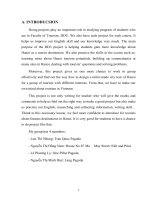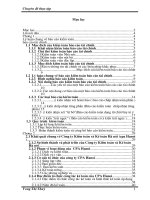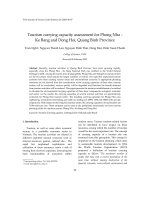Hanoi tourism potentials.DOC
Bạn đang xem bản rút gọn của tài liệu. Xem và tải ngay bản đầy đủ của tài liệu tại đây (1.91 MB, 38 trang )
A. INTRODUCSION
Doing projects play an important role in studying program of students who
are in Faculty of Tourism, HOU. We also have each project for each course. It
helps us improve our English skill and our knowledge very much. The main
purpose of the HD3 project is helping students gain more knowledge about
Hanoi as a tourist destination. We also practice the skills in the course such as:
learning more about Hanoi tourism potentials, building up commentaries at
many sites in Hanoi, dealing with tourists’ questions and solving problems.
Moreover, this project gives us one more chance to work in group
effectively and find out the way how to design a tailor-made city tour of Hanoi
for a group of tourists with different interests. From that, we have to make our
own mind about tourism in Vietnam.
This project is not only writing for teacher who will give the marks and
comments to help us find out the right way to make a good project but also make
us practice our English, researching and collecting information, writing skill…
Thank to this necessary lesson, we feel more confident to introduce for tourists
about famous destinations in Hanoi. It is very good for students to have a chance
to do project like that.
My group has 4 members:
- Lưu Thi Nhung: Tran Quoc Pagoda
- Nguyễn Thị Hồng Nam: House No.87 Ma May Street; Edit and Print
- Lê Phương Ly: One Pillar Pagoda.
- Nguyễn Thị Minh Huệ: Lang Pagoda.
1
B. BODY
Pre – departure information:
Welcome to Hanoi!
As you know, Hanoi is the capital of Vietnam for almost a thousand years.
It is considered to be the cultural centre of Vietnam, where every dynasty has
left behind their imprint. Even though some relics have not survived through
wars and time, the city still has many interesting cultural and historic
monuments for visitors.
Hanoi has more cultural sites than any city in Vietnam, including over 600
pagodas and temples. Hanoi still preserves many ancient architectural works
including the Old Quarter and over 600 pagodas and temples. Today we have a
tour to discover the traditional architecture of Hanoi. So we design this tour with
some special pagodas and an old house in Hanoi. We hope that tourists who are
interested in traditional architecture of Hanoi will satisfactory with them.
Itinerary
Tour: Searching the traditional architecture of Hanoi
- 8:15 am: pick up tourists in the hotel
- 8:45 am: Tran Quoc Pagoda
The reason that it is considered a cultural symbol of Vietnamese Buddhism
partly for it is the oldest pagoda and situated in the centre of the capital of
Vietnam.
- 10 am: One Pillar Pagoda
Special and famous for its architecture, entire the pagoda is held up by only
one pillar, imitating the feature of a lotus (symbol of Buddhism). All the
building is situated in the middle of a pond of lotus.
2
The unique architecture is a whole column pagoda is set on a stone column.
It is a combination of reckless imagination romantic poetical images through
lotus and solution structure of wooden architecture in the system of foundation.
- 11am: have lunch in restaurant in the Old Quarter and rest.
- 1pm: House at No.87 Ma May Street
The house at 87 Ma May Street is typical of architecture in Hanoi’s Old
Quarter. It has shown the technical and arts building traditional old town of
Hanoi. It is the art of building with traditional systems for tractors decorated
wooden carving stations, construction techniques under the brick walls, floor
systems via wooden bricks.
- 1:45 pm: come back to the bus to go Lang Pagoda.
- 2:15 pm: Lang Pagoda
Lang pagoda is one of the most ancient pagodas in Hanoi. The architecture
design of the pagoda is harmonious, stretching from the three entrances to the
worshipping house. The multi – layer architecture structure with a green
courtyard makes the ancient and sacred atmosphere of a Vietnamese pagoda.
- 3:15 pm: finish the tour and take tourists to hotel.
3
TRAN QUOC PAGODA
I would like to introduce to you one of typical traditional architectures of
the Hanoians is an old pagoda architecture. Today we will visit Tran Quoc
pagoda: one of the oldest pagodas in Hanoi. You know, Pagoda is the place to
worship Buddhism and before introduce about the Tran Quoc pagoda’s
architecture. I want to introduce to you briefly information about the Buddhism
in Vietnam.
1. Buddhism in Vietnam
Vietnam is the nation without own religion but Buddhism still played an
important role in the life of Vietnamese with 90% populations. Buddhism came
to Vietnam by the maritime route from India and from China by land. Those
who first carried this religion to Vietnam seem to have been refugees from
persecution in China and religious pilgrims from India.
Buddhism could be found in Tonkin (North Vietnam) in the second century
A.D. North Vietnam was the cradle of the ethnic Vietnamese culture as it was
not until 1802 that the southern area, including the delta, was conquered and
consolidated into the approximate area of Vietnam today.
The North of Vietnam follows Dai Thua (Great wheel) and the South is
Tieu Thua (Small wheel).
Do you know what the wheel is?: This is one of the earliest symbols of
Buddhism, and consists of a circle (wheel) with eight or twelve divisions
(spokes). The circle denotes the Buddhist concept of repeated births and endless
existence. Eight "spokes" signify the Eightfold Path to reach Nirvana; and
twelve "spokes" denote either the twelve "Principles of Buddhism", or the
twelve-year calendar within an endless cycle of time.
4
Throughout twenty centuries in the long history of VN, Vietnamese
Buddhism has been closely linked with the survival of the nation, whether in its
rise and fall. Since the early days of its introduction, the mind of Vietnamese
Buddhists has been so well imbued with the Buddha‘s Teachings about love,
tolerance and sympathetic understanding that Vietnamese Buddhism has been
able to co-exist in peace with other religions for over 2000 years. On the one
hand, generations of Vietnamese monks and nuns and lay followers, unknown or
well-known, have somehow participated in making it a unique Vietnamese
religion colored with Vietnamese ways and customs. On the other hand,
Vietnamese Buddhism has had a great influence on Vietnamese literature, art,
music, architecture and Buddhism, so to speak, has become a part of Vietnamese
life.
2. Tran Quoc pagoda
2.1 Location
Tran Quoc Pagoda is located beside the dazzling West Lake, on Thanh
Nien Road, Hanoi. Particularly, it is seated on an island linked by a bridge to the
causeway between the two most romantic lakes of Hanoi: West Lake and Truc
Bach Lake.
2.2 History
The construction of the pagoda started in 541 and was completed in 545
under the reign of King Ly Nam De (544-548) under its original name of Khai
Quoc (National Founder). It was initially built on the bank of the Red River.
Until the early 17
th
century, under the reign of King Le Kinh Tong (1600-
1618), the pagoda was moved to the Golden Fish Islet due to the river bank
crumbling and was renamed Tran Quoc (National Defence).
5
2.3 A cultural symbol of Vietnamese Buddhism – the pagoda’s architecture
You might ask yourself why among a number of beautiful pagodas in
Hanoi, Tran Quoc should be visited. The reason is from the fact that it is
considered a cultural symbol of Vietnamese Buddhism partly for it is the oldest
pagoda and situated in the center of the capital of Vietnam
Tran Quoc pagoda’s layout follows the "noi cong ngoai quoc" architectural
style. This is the typical and traditional architecture of the pagodas in Vietnam
with featuring three rows of buildings: three-compartment Thuong dien
(Sanctuary), Thieu huong (Incense Burning House) and five-compartment Tien
duong (Ancestor-worshipping House) ) connected to two corridors, bell tower,
Ancestor House and Headstone House. There are remaining 14 stone steles
carved much precious documentation and described sufficiently the constructive
and repairing process. Especially, the
Pagoda has a statue of Thich Ca Buddha made of gilt wood and Big Tower
Garden.
No one who has visited this significant pagoda of Hanoi does not take
interest in its special and intricate style of architecture dated centuries ago.
2.4 A nice tranquil backdrop
It must be said that the island and pagoda provide a beautiful backdrop,
particularly when viewed at sunset. Standing at one end of Thanh Nien Road,
one can see the towers of the pagoda rising above the lake’s surface. In the
pagoda’s garden stands a Bồ Đề (Bodhi) tree, which is attached to a past story.
The story tells that in 1959, on his visit to Vietnam, Indian Prime Minister
Razendia Prasat offered the Pagoda a bodhi tree as a gift. The plant was grafted
from the holy bodhi tree where Sakyamuni sat in zen (meditation) position and
achieved enlightenment in India 25 centuries ago. Now the bodhi tree is easily
recognizable from its heart-shaped leaves, taken from a cutting of its original
6
tree. Today, the tree green and luxuriant, shading over part of the pagoda's yard.
These days, Tran Quoc Pagoda, as a religious relic with spectacular
-surrounding scenery, is a favourite stopover of so many foreign visitors and
pilgrims.
3. Bao thien tower
As you can see the tower’s name is Bao Thien. It includes 11 floors, 15
high. Each floor has 6 small vaulted roofs, Adida Buddhist statue that made of
rare stone and the total are 66 statues. The tower’s construction started in 1998
but there were some reasons so until in 2003 it has finished.
Then I will tell you one small story about the tower in Tran Quoc pagoda’s
garden that Kim Cuong Tu Buddhist monk leaded the pagoda and respond to
build in XI century. He is the superior Buddhist, high position in Buddhism and
always is delegate of national assembly. When building the tower, someone said
that he built it to after he died his ash will put in this tower. However, some
warmed-heart ones still understand and respect his work because there are many
projects, restaurants and hotels growing up…it seems to swallow West Lake.
Therefore, he knew that this tower’s building is to make harmony of the sacred
land, of the pagoda. Then when he passed away, the tower of Tran Quoc pagoda
keeps country, protects Thang Long citadel. Nowadays it becomes a very
valuable and rare project.
Problem in Tran quoc pagoda:
Your group comes into Tran Quoc pagoda. In front of pagoda, some
tourists want to take photos but many sellers around there coming and ask them
buying some things. They refuse buying anything but the sellers still ask with
insistence, make noise and follow your tourists.
- Solving problem:
7
Come closely with your tourist. Talk in a polite way with the seller that
your tourists do not want to buy anything.
Questions:
1. What are the names of two lakes in front of Tran Quoc pagoda?
- Ho Tay: West Lake
- Truc Back Lake: White Soul Lake
2. What is the meaning of “noi cong ngoai quoc” architecture in pagoda?
Internal attack with outside support
3. Why there often has tower garden?
To keep the bone-ash of monks
4. Why does each tower have different height?
It depends on the position of the monk.
5. What are four sacred animals?
Dragon, phoenix, unicorn, tortoise
8
APPENDIX
Bao Thien tower
Tower garden
9
The gate of pagoda
The roof of pagoda
10
The way in pagoda
11
THE ONE PILLAR PAGODA
The One pillar pagoda is one of the most popular tourist attractions in
Vietnam. It was built in 1409 under the Ly dynasty. In Vietnamese, it has named
“Dien Huu tu” which literally means “Long lasting happiness and good luck”.
The unique pagoda is located in the western part of the city, near Ho Chi
Minh’s Museum, Ong Ich Khiem St, Ngoc Ha, Ba Dinh District in Hanoi.
1. History
According to legend, Emperor Ly Thai To – the first King of Ly dynasty
was very old and had no children. He used to go to pagodas to pray to Buddha
for a son. One night, he dreamt that he was granted a private audience to the
Goddess of Mercy, who was seated on a great lotus flower in a square-shaped
lotus pond on the western side of Thang Long Citadel, gave the King a baby
boy. Months later, when the Queen gave birth to a male child, the Emperor
ordered the construction of a pagoda supported by only one pillar to resemble
the lotus seat of his dream in the honour of the Goddess of Mercy. According to
a theory, the pagoda was built in a style of a lotus emerging out of the water.
The pagoda was built in 1049 during the Ly dynasty. At this time, the
Buddhism was becoming popular in Vietnam.
2. Architecture
- Special and famous for its architecture, entire the pagoda is held up by
only one pillar, imitating the feature of a lotus (symbol of Buddhism). All the
building is situated in the middle of a pond of lotus.
It is called Lotus Court a square column with a 3m-dimensional, curved roofs of
the stone column cylinder 4m high (not including the underground) has a
diameter of 1.2 m. Head including 2 stone blocks, fitted very smart, espy a rock
line.
12
- The unique architecture is a whole column pagoda is set on a stone
column. It is a combination of reckless imagination romantic poetical images
through lotus and solution structure of wooden architecture in the system of
foundation. Especially using large columns overlap column from the floor,
create the stable, just bring aesthetic effect such as eel's wings shower, setting
the harmony between the roof and floor by a virtual match.
- Along with pond square below may be a symbol for the round holes,
square meters of land, as reaching the pagoda on the idea high: charity light the
world. Wood block architecture has been assisting by landscape, with pond, with
trees has created a closer, but still pure fine. Feeling bar's architecture as share,
harmony with heaven water and green leaves of the trees makes people
attractive clean your troubles, reached in the light of the soul.
A narrow flight of stairs leads to the tower where there sits a gilded figure
of Goddess of Mercy, to whom the pagoda is dedicated.
And the altar in the small shrine, a gilded figure of Goddess of Mercy sits
in the dim interior upon lotus blossoms. The lotus throne in Buddhist
iconography is reserved for those who have obtained "perfect comprehension."
- Every month, on the first and fifteenth, the king together with the queen,
her attendants and courtiers, went to the pagoda to pay homage to the Buddha.
Every year on April 8 (lunar year) the king went to the pagoda on the eve of the
Buddha's birthday to keep himself pure and calm and to prepare for the Buddha-
bathing ceremony the following morning. On that day, there was a grand
ceremony called “Phong Sinh” festival (animal - releasing ceremony) in front of
the pagoda. After the Buddha-bathing ceremony, the king stood on a high
platform, began releasing a bird. So on that day sky was filled with release birds.
- Sadly, the first One Pillar Pagoda was destroyed during the French War in
1954. The new Vietnamese government rebuilt the temple in 1955 and still
commemorates the legend of Emperor Ly Thai Tong. This is an architecture
13
combine’s creative space architecture with high-low rhythm including stone
sculpture, Painting, drawing touches corridors, the water is a symbol of culture,
high art, and the deep ethnic lines. It has been devastating; rebuilding small
compared with original sample, repeat here in a cluster has a unique
architecture.
- It was built of wood on a single stone pillar 1.25 m in diameter, and it is
designed to resemble a lotus blossom, which is a Buddhist symbol of purity,
since a lotus blossoms in a muddy pond. Before the pagoda was opened, prayers
were held for the longevity of the monarch, hence being considered a temple at
that time. During the Ly Dynasty era, the temple was the site of an annual royal
ceremony on the occasion of Vesak, the birthday of Gautama Buddha. A
Buddha-bathing ceremony was held annually by the monarch, and it attracted
monks and laymen alike to the ceremony. The monarch would then free a bird,
which was followed by the people.
- In fact, there are some copies of the One pillar pagoda in the world. There
are one in Ho Chi Minh City and one in China. The copies were built to show
the relationship between two countries.
This unique shape of the pagoda together with the special story has been of
great absorption to hundreds of thousands of international tourists!
Questions
1. When was the One pillar pagoda built?
In 1409 under Ly dynasty
2. Who is worship in One pillar pagoda?
Goddess of Mercy
3. Why has One pillar pagoda become famous?
14
Special and famous for its architecture, entire the pagoda is held up by only
one pillar, imitating the feature of a lotus (symbol of Buddhism). All the
building is situated in the middle of a pond of lotus.
4. What do the name “Dien Huu tu” mean?
It means “Long lasting happiness and good luck”
5. When was One pillar pagoda destroyed?
In 1954 by the French
Problem
Each stop has some specific rules. Tour guide should explain for tourists to
make the tour more smoothly and successful.
- In One pillar pagoda, we have some specific rules:
Firstly, please do not turn the back to the altar because it is taboo in
Vietnam.
Secondly, please do not make noises and keep quiet to show respect to the
sacred place.
Thirdly, please do not throw the rabbits on the floor to protect environment.
To avoid getting lost, tour guide should set the meeting point for tourists.
15







